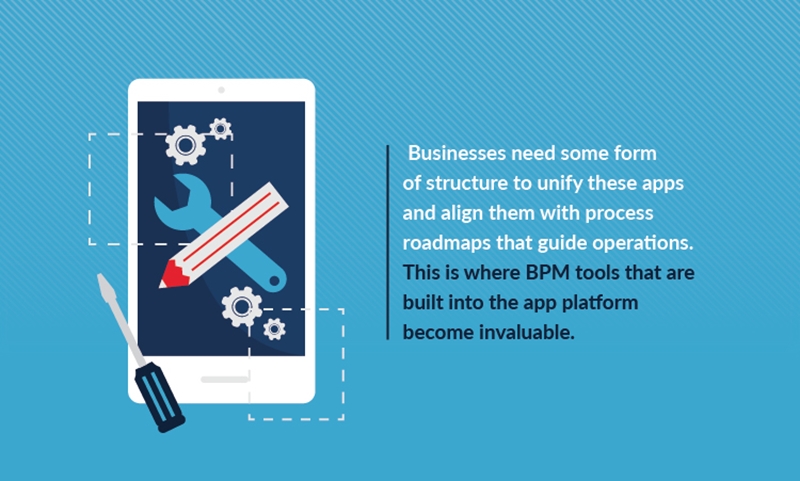Mobile App Platforms Play Essential Role in Capturing User Attention
Blog: Appian Insight
The application economy is transforming the enterprise as we know it. An App Annie study predicts that the global app economy will create annual revenues climbing to $101 billion by 2020. That figure is estimated to rest at $41.5 billion for 2016, meaning the market will likely double its value before 2020. What’s more, this growth comes from across a wide range of industries, with organizations from the financial services, retail and public sectors all getting involved in app development, VentureBeat reported. This focus on apps can be a game changer for the enterprise. However, keeping up with the demand for mobile applications can put a huge development burden on IT teams, and organizations must be prepared to adapt if they want to truly empower the mobile user.
Mobile App Platforms: More done, right now »
Responding to an app-centric world
eMarketer found that approximately 85.7 percent of time spent on smartphones is spent using apps. That compares to just 14.3 percent of time devoted to activity on the mobile web. Usage patterns have spoken—people tend to prefer apps for their their accessibility, immersion and capabilities when compared to the mobile web. What does this mean in the enterprise?
“We’ve gone from consumerization to full-on digital transformation.”
The consumerization of IT has been a talking point for a few years now, so much so that it is no longer a buzzword. The reason is simple—we’ve gone from consumerization to full-on digital transformation. Mobile devices have become pervasive to the point that organizations aren’t just being asked to support email and basic collaboration for mobile users. Instead, workers are demanding full access to business tools with equal quality regardless of the device they are using. The modern enterprise faces incredible pressure to adapt all of its processes and procedures around digital technologies, something that requires innovative mobile app platforms to help companies keep up with demand.
The challenge here is that consumerization hasn’t disappeared. Instead, it has been folded up into the idea of digital transformation. If the consumerization of IT movement was marked by users demanding some degree of ownership over their technology decisions and expecting greater responsiveness from IT teams, digital transformation takes those requirements to another level. This has fueled an app-centric world in which businesses are expected to be able to say “We have an app for that,” when asked for just about any solution. If you don’t already have an app for that, you need to be ready to make one, and that’s where mobile app platforms come into play.
 Process excellence underpins digital transformation.
Process excellence underpins digital transformation.Fast-Track Your Digital Transformation »
From consumerization to transformation
Consumerizing IT often boiled down to offering an illusion of choice to satisfy business users’ demands for apps that meet their specific needs. In many cases, this led to the creation of service catalogs where companies housed approved apps that workers could pick and choose from to get the job done. Mobile app platforms take this principle to another level, allowing for true digital transformation.
An application development platform will:
- Bring together data from a variety of apps and services under a central platform umbrella so it can be shared between users and services housed within the ecosystem
- Incorporate pre-built tools and low-code modules to empower non-tech users to develop their own solutions based on the infrastructure and operating system frameworks supported by the platform
- Allow for device-agnostic app development by default to simplify development and deployment tasks
- Automate documentation of data workflows and app processes within the platform for auditing and regulatory purposes
When these features come together, organizations can establish app ecosystems in which users don’t have choice, but also have the ability to solve their own problems using low-code tools. The implications here are fairly significant—IT manages and oversees the platform itself, setting rules and regulations to keep data safe, but business users can create the solutions they want to get the job done. This ecosystem is effectively a candy store for an app-hungry enterprise workforce, and business process management (BPM) software takes the functionality to another level.
How Modern BPM Can Transform Your Business »
Adding BPM to the low-code platform framework
“BPM serves as a skeletal system upon which the body of an app ecosystem is built.”
Digital transformation isn’t achieved by letting users run diverse apps on whatever device they feel like using. This level of app penetration is a step in the right direction, but it can easily become problematic. Businesses need some form of structure to unify these apps and align them with process roadmaps that guide operations. This is where BPM tools that are built into the app platform become invaluable.
BPM software has long helped companies structure, standardize and automate their processes. Add that functionality to app creation, and users can effectively build their apps around specific process requirements. BPM serves as a skeletal system upon which the body of an app ecosystem is built. All told, app platforms are empowering the mobile workforce to drive digital transformation through intelligent development in the hands of business users.
The post Mobile App Platforms Play Essential Role in Capturing User Attention appeared first on Appian Blog.
Leave a Comment
You must be logged in to post a comment.








